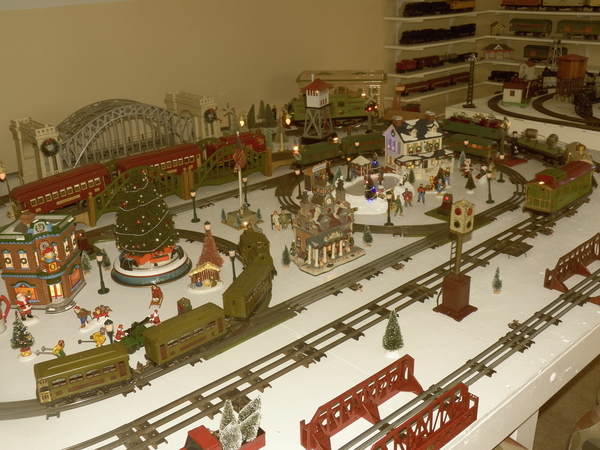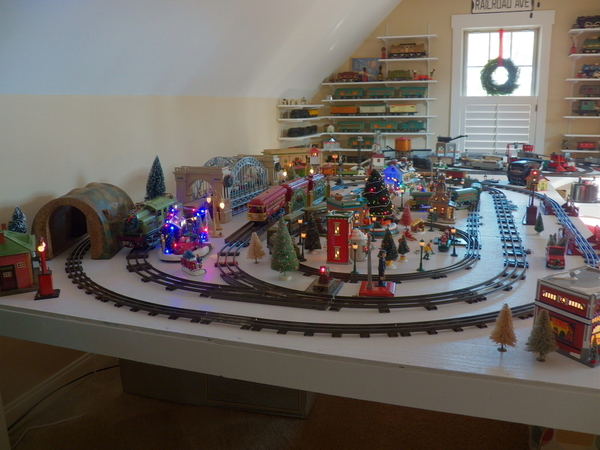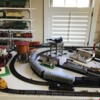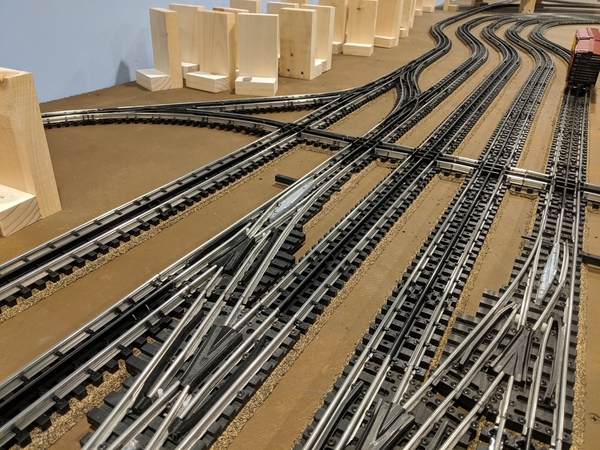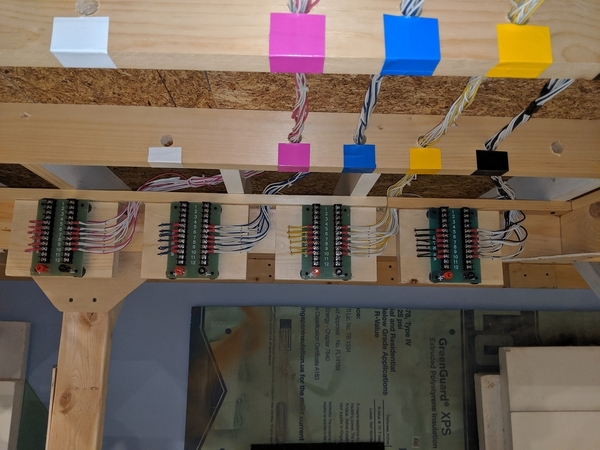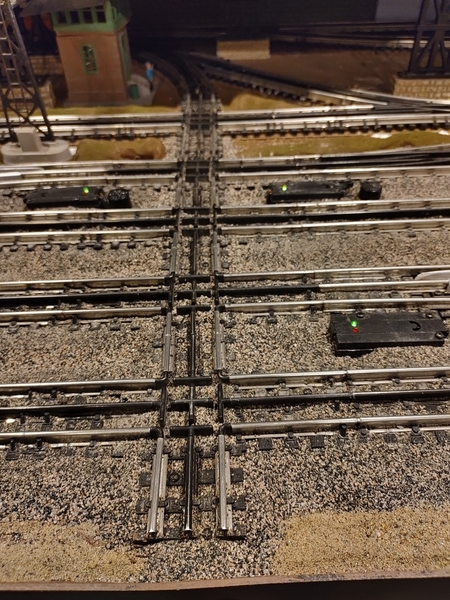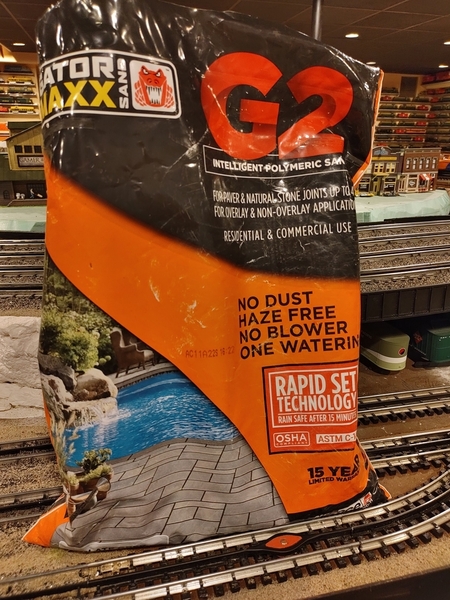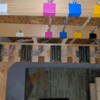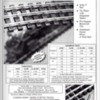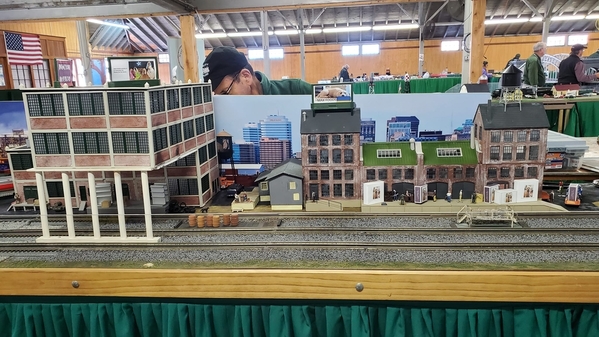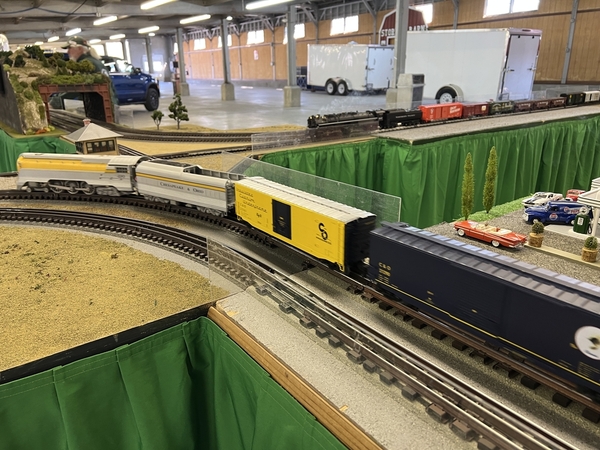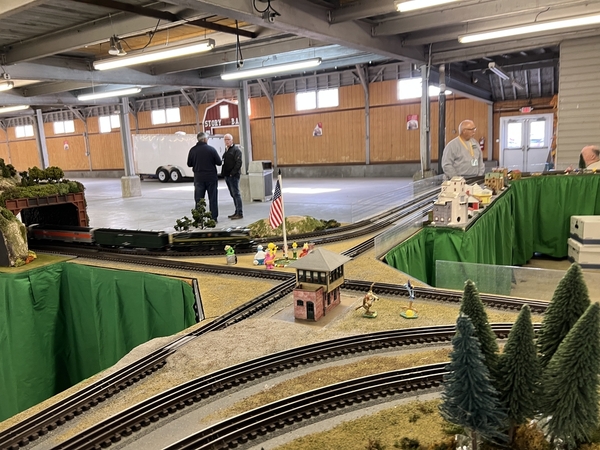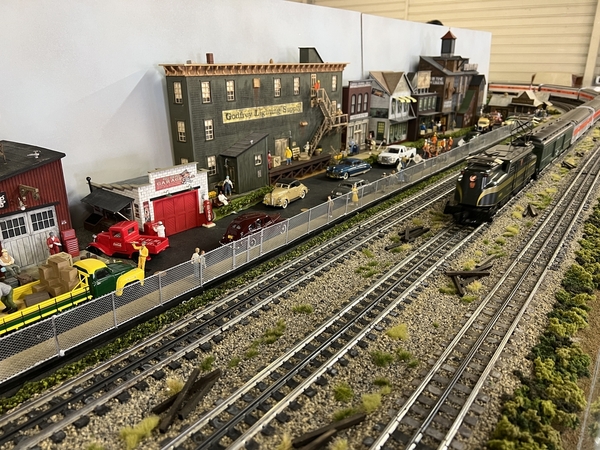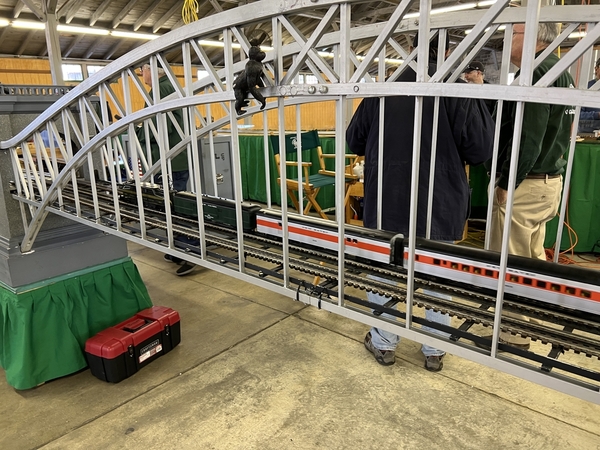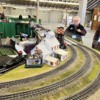Is hollow rail tubular or solid rail better for O gauge track and why? Also does the type of "preferred" rail depend on the curves used or other factors? Is there an optimal rail type for electrical conductivity or transmission of either tmcc or dcs signals?
Replies sorted oldest to newest
It depends on what you want to do. If you are building a postwar layout, then the obvious choice would be tubular track. If you want to build a hi-rail layout then either Atlas or Ross Custom track and switches would be better for that. I am not aware of any brand that works best for TMCC or DCS.
Electrically, with adequate buss&drop wiring any brand/type will work well. Operationally, installation is the critical thing rather than brand or type. Some brands are hard to find (MTH Scaletrax) and some are everywhere (Lionel Fastrack). It comes down to personal preference and that is largely in regard to appearance and/or ease of installation. If you are starting out I recommend doing searches of this forum and reading hundreds of posts and looking at lots of pics. If you have access to a LHS go there and look at different types/brands of track.
The best type of track depends on how severe the coning angle is on your wheel. O GAUGE (3-Rail) trains like Lionel, American Flyer, MTH 3-Rail, Atlas 3-Rail, etc have thick wheels with very steel coning. This is to negotiate sharper turns at higher speed (from my understanding). The rounded rail head of Lionel tubular track, MTH Realtrax, Lionel Fasttrack, is really good for those kinds of wheels because at high speeds there is more of a contact area on the coning. Now if your eyes are sharp, you will notice that there are 3-Rail track systems that have more traditionally shaped "I" rails. That kind of rail is on track systems like ScaleTrax and Atlas O track.
I'll throw this out there too. O SCALE (2-Rail) only has "I" shaped rails because it is meant for scale wheel sets that do not have steep coning angles on the wheels. You mostly hand-lay or use Atlas 2 Rail track in that case (maybe Peco but that's not as common in the States).
What look are you going for? That is a big factor in which track you want to get. In terms of the electrical conductivity, all the major brands right now are pretty equal. Lionel has stopped making tubular track as I understand; the Fasttrack system is rounded just like the old tubular system and has a similar rail profile. But the look is what really makes the brands different. Fasttrack is pretty good. I'm biased towards MTH when it comes to 3-Rail so I tend to say Realtrax is my go-to. Atlas 3 -Rail track is pretty good; it has the proper tie spacing. Scaletrax has the lowest (most realistic) profile in 3-Rail as far as I'm aware.
That's about as much as I know. Hope that helps!
Mine is a largely switching Pike so I use Fastrack because I knew I would be making a lot of track-plan changes&tweaks and Fastrack is that: fast to lay. I may eventually have a do-over to Ross Custom switches and Ross track with Ross Bed because appearance: ballasted "t" section track.
The answer to your question really depends on you, do you currently have any track inventory you want to make use of, what type of trains will you be running, how much do you want to invest in the track, is this a model railroad or a toy train layout, and lastly what looks best to your eye.
I use Lionel Super O track and switches on my postwar layout and use vintage standard and O-Gauge track and switches on my prewar layout. Why, because I have amassed a lot of it in very good condition over the years. I didn’t want to invest money when I didn’t need to, I wanted to eliminate a few boxes from storage. Frankly, I like the look and sound of it. I have a toy train layouts, attempting to keep period specific. I enjoy watching the train’s running the loops or operating those postwar accessories.
Attachments
It will come down to personal preference, there have been a lot of threads on here about track, and no track is 'the best', in the sense it comes down to 'what is the best for yourself'. If you are looking for the most prototypical look, then MTH Scale Trax or Atlas is usually the choice; downside on these is both the cost, and availability of the track. Fast Track is relatively easy to work with, because it is track and roadbed in one, it is readily available; the downside is the cost, and it tends to be noisy, and it isn't the most realistic looking (though people have various tricks that can make it look pretty good). Gargraves or Ross track are decent looking, though the rails are tubular and the ties are not prototype profile,they tend to be less expensive than the other choices and gargraves has a decent flex track. Ross switches seem to be a favorite of a lot of people, people using other track systems seem to go with Ross switches, and if I had to hazard a guess among hi rail modellers the most common pairing is gargraves track (or ross track, which is almost identical) with Ross switches. Big advantage with Ross/Gargraves besides prices is they are readily available, in large part because they don't have the issues with shipping from overseas the other brands can have.
Tubular track, though Lionel is not making it any more, is still readily available and is cheap. Besides the ton of used and NOS track that is out there,Menards is making tubular track as well. Tubular track is toy like (metal ties, only a couple of ties per section), the track is not scale proportioned. You can make tubular track appear better, though, if you ballast it and put extra ties under the rails and weather it, and you can't beat the price. If you are looking to recreate a toy train layout kind of feel, it is what I would use.
In terms of power distribution and TMCC/DCS signal, any of the tracks should work fine. Atlas has one advantage with their nickel silver track, besides the fact it doesn't rust, it also should be a better conductor vs steel, though I suspect any advantage it has is pretty small.
One other thing to consider, and that is the equipment you will be running. Some post war equipment with the really big wheel flanges may have trouble with lower profile track like Atlas and Scale Trax. Tubular is tall enough it can run anything, and gargraves track (and ross, which has a similar profile) was created during the post war period and should be able to run anything. If on the other hand you are running modern trains, especially scale ones, that might not be a concern.
My choice at this point is going to be Gargraves and Ross switches (though I might use strictly ross track if I decide not to use flex track), it has a sweet spot for price and looks for me and will likely run any equipment I have.
I wouldn't overthink it. I've got Gargraves, and hand-made many of my own switches. Some very early prewar engines with large gears don't like the Ross switches. That's why I ended up making my own. To my knowledge, anything beyond early prewar will work with any track system.
Don't forget to consider that some tracks have better magnetraction adhesion properties should that be important to you.
Also, if you are doing planning on singnal block activation, some track, like Gargraves, is manufactured completely insulated rail making that task much easier from the get-go.
I'll make it easy for you: Atlas O (for O36 only) or Ross (for O42 & up.) Don't build a layout with less than O36 unless you're really squeezed for space.
My $.02 but I've been doing this for 46 years, what do I know.
Layout done with used Gargraves track, used Gargraves, and Ross switches. Tom's layout build. Click on the underlined phrase to access a slideshow, (60 pictures)

I think if you look at enough photos on here of the various layouts one type of track will begin to stick out more than the others to you.
We use a combination of Lionel Tubular, Gargraves, Ross Switches, and one section MTH Scaletrax. The original part of layout was originally Lionel tubular which was later replaced with Gargraves and Ross Switches. There is one section under a mountain that had to remain Lionel tubular. When we installed DCS we had a low DCS signal problem on this particular section. After hours of troubleshooting we had to isolate the Lionel tubular section and run a separate feed to it. It is a short section but when tied into either of the other two blocks on this line the signal degraded to 3 or less. Talking to one of the techs at MTH it was believed that the tubular track was causing a signal bleed degrading the signal. We were not able to determine if it was the track in general or just one section of track that was causing the issue since that would have meant tearing out the mountain to remove any of the track. We used the star wiring method on the entire layout. The DCS signal has been strong on the rest of the layout. I also use DCS on my home Atlas track layout. Never had any signal problems there.
Forest
My top pick would be GarGraves track and Ross switches. I love the looks of this combination, especially since I'm gravitating towards Hi-Rail. I'm currently starting to build a modular layout with this system. I also like MTH Real Trax, regardless of the "cons" this system can have. I've figured out how to solve the problems that can and do occur with this track. Not a bad looking track, and I can find really good deals on it at train shows.
One thing to keep in mind, you have to be a little more careful with hollow rail sections than solid rail sections. As far as being easier to dent or otherwise damage. In other words, don't drop a hammer or set extremely heavy objects on hollow rail sections , you can easily damage the rail if you're not careful (don't ask me how I know ![]() ). Solid rail sections are a lot more robust, of course.
). Solid rail sections are a lot more robust, of course.
Bottom line - there probably is no one best track. Do a bunch of research, and go with whatever YOU decide you like best! ![]()
This is a loaded question only second to; Blonde, Brunette, Redhead, which is a better choice for a wife?
GarGraves with Ross switches is a very popular combination on this Forum. There really isn't a "bad" track" choice. A lot of it is "the look". That leads you back to the #1 loaded question... If price is the controlling factor, you can't go wrong with good old Lionel tinplate. It still works just fine.
Atlas is Nickel Silver, and GarGraves offers Stainless steel rails. If moisture (corrosion) is a potential problem, these are two good choices. Both Atlas and GarGraves have nice track feeders. Ross uses the same track pins as GarGraves, so their products can be interchanged.
As for curve diameter, pick the biggest thing that will fit in your space.
My $0.02
I use 027 height track with 054 and 072 curves and extra ties (027 profile 072 curves were made by K-line and are almost impossible to find now. I bought them around 2009) and Ross switches. Seems to work fine for my needs. Gargraves/Ross track is actually about 1/8" taller than 027 profile track.
Next layout (Aren't we all planning for that?) will probably be all Gargraves or Ross track with Ross switches. I'm going that route for wider curves than 072.
I have a post elsewhere on this. The tubular 0 rail was the same Lionel used for their old standard gauge track and was more reliable for prewar locomotives. "But it's so unrealistic." However you can get commercial ties that match, or make your own, and the added height allows enough room for ballast, even on the switches (Clump and Seal Slider cat litter makes excellent 0 scale ballast). Then paint the rails (black in center) and it looks pretty darn good in addition to reliability.
My layout is 45'x25' with three levels and is a true point to point configuration and is double tracked with some sections triple tracked. I have used exclusively Gargraves track with no regrets. I have approximately 50 switches and all were Gargraves at the outset of the layout 35 years ago. I have replaced some of the critical location switches with Ross switches where derailments were a problem (access). I found the Gargraves track easy to flex for curves and special places. Foe me, it was the best selection.
I’m the guy if you need some gargraves track. I have a lot of straight sections, some flex track, a lot of 0100 switches and various diameter curve and switches. These have been accumulated through the years and is more than I’ll ever use - pretty much done with the layout.
My email is in my profile
RMT and KLINE super snap shadow rail track on entire layout. 200ft mainlines. RMT 0-72 switches + ROSS tinplate 0-72 switches. Glad RMT made 30 inch and 40 inch Super Snap straights. Power drops every 6 feet + use metal pins between track sections. TMCC + DCS + Conventional. All trackage with 4 1/2 inch centers.
Ballasting is done with paver 'sand' that is coated with a cement that is water activated. Just apply to trackage dry and spray from water bottle - no soapy water needed - just tap water. Comes in 3 colors - grey for mainline, black for yards and beige/sand color for dirt. About $35 for a 50 pound bag. Easy to work with too. So far have used 200 pounds of grey.
Really nice to hear 'clickety-clack' when trains go over crossings.
Wiring color coded through the layout supports.
Walter
Attachments
My layouts from 1981 thru 2010 were always Lionel tubular track.
I decided to use prewar Lionel t-rail track. Not many people using this track but for me that was a really cool selling point. Very expensive if you can find it with price's around $20 to $30 per track. The track is amazing and I love it. Besides being very expensive and hard to find it can also be a challenge to assemble. But again I like having something different and rare. I run all Lionel from 1910 to 2023 trains. Conventional and command.
I agree, this is one of those no right answer deals....for what its worth, our layout is Realtrax with 031 and 042 curves. Its all we could fit with the space we had at the time, and we were heavily invested in Realtrax. Just didn't know any better. Now that we are expanding the layout and know better, we are using Gargraves track and Ross Custom switches. Our curves will be 072 and the switches will be at least that size or larger. The Realtrax is fine but the switches are not reliable at least in my experience. After much adjustment, they work and we will be leaving the old portion of layout as is. It works. We now have larger locos that need the larger radii as well. I like the look and functionality of the Gargraves, Ross combo. We have already started experimenting with laying some of the new track, and it is very nice and great to work with. Good luck finding your track. Took me a lot of years to make a decision.
I've used tubular, Fastrack, and I did the most recent build with Gargraves track and Ross switches. We used Atlas track/switches on our modular club layout, but we're changing to Gargraves/Ross.
I have two layouts. The original was Gargraves which I eventually donated and rebuilt for a museum, and the smaller replacement layout on my workshop floor is a lot of 072 track and switches which I acquired almost by accident. All I'm saying is with a little effort it can look pretty decent.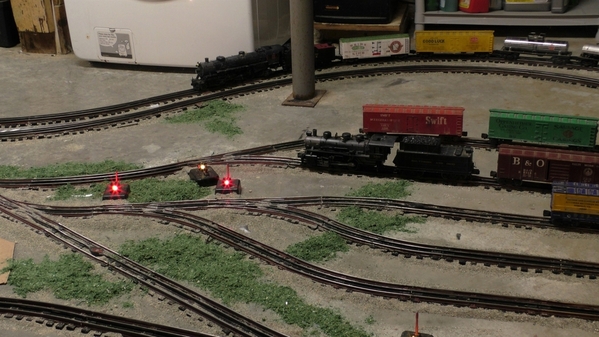
Attachments
Saw this at the Springfield MA. Show. Maybe the early to mid 90’s. There was a section mounted on roadbed with ballast. Don’t know what became of it. Back then the only competition was Gargraves flex. Ross and Curtis made turnouts but I think sectional track was a few years away. Lots of options. Maybe to many. With different rail heights and materials.
Attachments
I can certainly identify with all the misgivings SIRT covered. I'm quite surprised after all these many decades a top-flight track system with easy assembly, improved scale proportions & components (and reasonably priced, of course!) has never been successfully introduced. Nevertheless, I've gone the ubiquitous G.G./Ross route after several years with Fastrack. For me (like many others), the primary motivation to change has been noise control without having to undertake any one of the numerous and dramatic mitigation efforts with Fastrack covered in many other threads.
Walter M., that is certainly a unique ballast application--I've never seen that product used before!
Tuscan Jim...Corsair 29 turned me on to that 'ballast gravel' type. It is great and much less expensive too!
Walter
@Walter Matuch posted:Tuscan Jim...Corsair 29 turned me on to that 'ballast gravel' type. It is great and much less expensive too!
Walter
Great technique to pass on. Thanks!
Love my super snap/shadow rail track, wish it was still being made!
This is the Tracker layout that I participated in October 2022.
Five brands of track: tubular, Atlas, Ross, Gargraves and K Line Supersnap…….and we got it to work!
It all boils down to finances, space and your personal style/preferences.
Peter
Attachments
If you run your trains on the floor, and you live on the edge of a known flood pool (as in one of the window wells turned into aquarium), tubular. Around the year 2000 my motto was, its a good deal if its 10 cents an inch. So a 10" section $1, 40" section, $4. Would probably have to adjust that for inflation.
I have bought Menards tubular, the steel is thick and plated, but the pins are not anchored well, and at times its a bit too wide. I came up up with a method, but just last night put an order in for one of tinman3rails kits. What Menards has is a) O-96 and b) could pick it up on the way home from work (Morton Grove, IL).
Now I see why Walter Matuch had the rights to K-Line track for a while. Nice.
What a great batch of contributions. Tubular was introduced by Lionel because it was cheap, easy for kids to handle, and those massive standard gauge engines needed the heavy rail. All model trains, after all, were considered "toys." Whatever you call what you have today is irrelevant, as long as you enjoy it! My early "scale" layout was started in the mid 80s when Gargraves was essentially the only plentiful realistic alternative. Now thanks to all for highlighting the many choices we have now. Pictures of my layout at strasburgmuseum.org
I haven’t seen it mentioned, but, I haven’t read every contribution from every poster to this thread.
For me, another important consideration is noise. Realtrax and Fastrack, with plastic roadbed, are inherently more noisy, and that’s important, especially if you are running modern trains with Railsounds, and other proprietary sound systems. The track noise will increase with the speed of the train. Another factor to consider.
@ogaugeguy posted:Is hollow rail tubular or solid rail better for O gauge track and why? Also does the type of "preferred" rail depend on the curves used or other factors? Is there an optimal rail type for electrical conductivity or transmission of either tmcc or dcs signals?
Per the OP's question about Conductivity, we came across this excellent article a few years ago: Testing 9 Types of Track
I would love to see an updated edition with Fastrack, Menards tubular and Supersnap track.
Magnetraction loves steel track, especially tubular and Atlas steel; it hates Gargraves stainless, MTH Realtrax, and Atlas's Nickel-silver track Bare metal wheels don't like RealTrax. Traction tires performed worst (though not by a lot) on Gargraves track.


